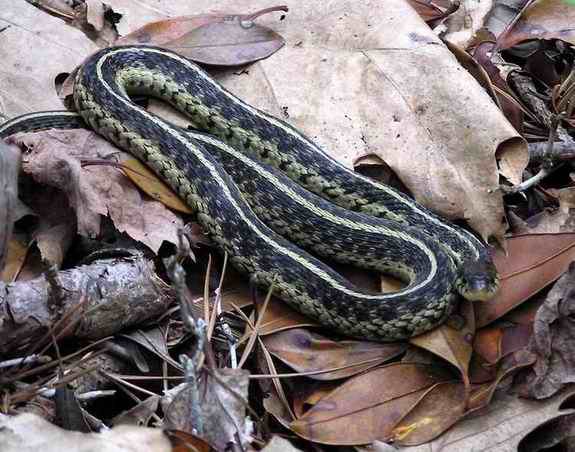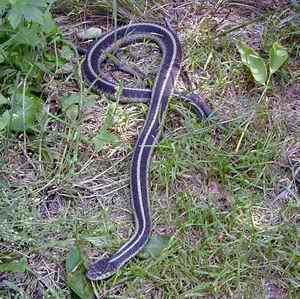|
Return to Hiker's Notebook Home Page
Common Name: Common Garter Snake, Eastern Garter Snake, Garden snake, Grass snake, Striped snake - The longitudinal stripes were thought to resemble the stripes that embellish the classic stocking garter (from the Old French word garet; the small hollow area of the leg behind the knee).
Scientific Name: Thamnophis sirtalis - The generic name is from the Greek thamnos meaning "bush" and opho meaning "snake" in reference to their preferred habitat of wetlands where bushy vegetation is generally prevalent. The species name is derived from Latin that is roughly translated as "like a garter". Some texts differentiate the Eastern (Common) Garter snake as T. sirtalis sirtalis.
Garter snakes are the most widely distributed snakes in North America, ranging from Costa Rica to Alaska, the northernmost habitat of any snake. They are members of the family Colubridae, which comprises about 2,000 of the world's 2,700 known snakes in the suborder Serpentes of the order Squamata which also includes lizards. The colubrines (from the Latin root coluber, meaning serpent) have several shared characteristics, including a head as wide as or wider than the neck, well-developed round eyes, large, regular scales, and teeth on both jaws. Some have poisonous fangs in the back of the mouth but those in North America are harmless to humans.
Garter snakes have a highly variable coloration, though they generally have several distinguishing characteristics. The most notable features are three relatively light-colored stripes that run along the length of a darker body. The stripes are most frequently yellow-hued but can range from white to green or brown; the darker, contrasting body can be black, brown, gray, or olive green. The area between the stripes is usually embellished with spots that are slightly darker than the background scales. They range in size from 18 inches to about three feet in length and live about two years in the wild, though their longevity in captivity is considerably longer; the record is 10 years.
The profligacy of the Garter snakes is due to their behavioral adaptations that contribute to survival; opportunism in the choice of prey is one of their key attributes. As an example of this adaptation, a study of Garter snakes in California revealed that coastal snakes ate slugs while those inland would not. The researchers concluded that the inland snakes had evolved the chemoreceptor system against slugs in order to avoid leeches, which were detrimental, potentially lethal, to the snake. Though Garter snakes feed on a wide variety of small animals including mammals, lizards and baby birds; their primary food source is earthworms, amphibians, and wetlands species such as slugs, snails, crayfish and fish. They are apparently immune to the toxic secretions of toads and consume them with no adverse repercussions. Using primarily excellent vision, Garter snakes are able to ambush their prey and affect immobilization with their teeth; the toxicity of the saliva accelerating the process. They generally do not constrict their prey, but rather consume it alive and whole.
As winter approaches, Garter snakes congregate in a den called a hibernaculum,
with hundreds of snakes sometimes sharing the same location. This has the
advantage of making the two sexes accessible for spring mating. The males
leave the den first to await the emergence of a female, which results in the
emission of competitive masculine pheromones. Some males have both male and
female pheromones, affording them an advantage in attracting the normal males
away from their bona fide quarry. This has led to the speculation that the
dual pheromone male variants may be in evolutionary ascendance. After the
female has selected an appropriate mate and retired to her summer habitat to
give birth; the males remain for the next female to emerge. However, female
Garter snakes are iteroparous; they can store sperm from mating in the fall
for use in the spring. The fall sperm may be allowed to degenerate if the
spring mating is a success. This adaptation further enhances the propagation
potential of the species as the female can select
The closely related Eastern Ribbon Snake (Thamnophis sauritus) is characterized by having the same three stripes as T. sirtalis; however, the two lateral stripes are slightly lower on the body and are absent any intervening spots. Also known as the slender garter snake, it is slightly thinner, an effect accentuated by its tail, which makes up more than one quarter of its overall body length. . |

 the
best mate Garter snakes are ovoviviparous, bearing between 10 and 40 live
young that are left to inherited survival instincts for food and predator
evasion.
the
best mate Garter snakes are ovoviviparous, bearing between 10 and 40 live
young that are left to inherited survival instincts for food and predator
evasion.